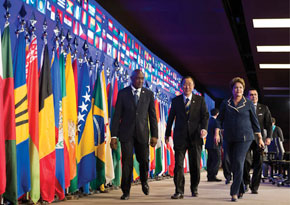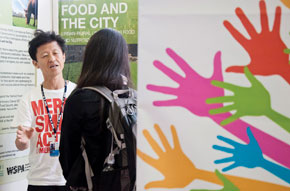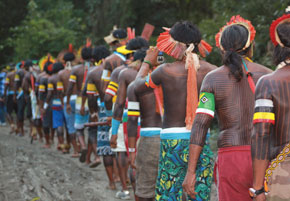From Rio de Janeiro

UN PHOTO / MARK GARTENBan Ki-Moon and Dilma, after the announcement of the final draftUN PHOTO / MARK GARTEN
The United Nations Conference on Sustainable Development (Rio+20), held in Rio de Janeiro from June 20 to June 22, approved a final document that was far from moving at the same pace as the planet’s environmental problems. However, the document did not backtrack. The 53-page report, approved by 190 heads of State or their representatives, was named The Future We Want. The definition of important issues was postponed until next year, when the Objectives of Sustainable Development are to be listed, with goals for water, cities, energy and oceans. If the discussions move forward, the objectives will go into effect in 2015. “The road will be long and hard” Ban Ki-Moon, UN Secretary General, admitted, referring to the work that diplomacy will be involved in for the next three years, as no consensus was achieved during Rio + 20 on the scope of the objectives.
Two work groups will be created: one will define the goals, while the other will discuss the means to help underdeveloped countries achieve them. Compliance with the goals will be voluntary. One positive outcome was governments’ commitment to implement a 10-year program to re-evaluate production and consumption patterns, an issue that has been discussed since 2004. “The tone of the document is positive, but the pace is very slow,” says Jacques Marcovitch, former president of the University of São Paulo from 1997 to 2001. “The challenge now is to build new coalitions in the sector or within a sub-national scope, to move forward by establishing appropriate metrics for specific topics,” he says, referring to the example of the successful soybean moratorium, a commitment undertaken by growers and exporters whereby they agreed not to sell soybean crops planted in deforested areas of the Amazon Region from 2006 onwards; another similar example is the labeling of automobiles according to their energy efficiency, a measure adopted by a number of countries. Marcovitch coordinated the study Economia da mudança do clima no Brasil: custos e oportunidades [The economics of climate change in Brazil: costs and opportunities], prepared by a group of institutions, which identified the main areas of vulnerability for Brazilian society and for the economy in relation to climate change.
The two main topics at the conference, namely, the green economy and reforms in the United Nations’ structure for sustained development, did not move forward. The green economy issue and the group of strategies to reduce the environmental impact of economic development, broadly – though vaguely – permeated the entire conference. Attention centered on issues such as efficient energy consumption and investments in low impact agriculture in underdeveloped countries. “It was an attempt to create a new motivating expression, but the expression wasn’t powerful enough, unlike the concept of sustainable development, which was the underlying issue of the Eco-92 Conference,” says Carlos Joly, a professor at the State University of Campinas (Unicamp), coordinator of Biota-FAPESP and senior advisor on biodiversity to the Ministry of Science, Technology, and Innovation (MCTI). The Eco-92 conference benefitted from the Brundtland Report, a document drawn up in 1987, which established the concept of broad sustainable development. This concept led to the global perception that sustainable development is not only based on an environmental cornerstone, depending also on economic and social ones. This clarity was not repeated in the green economy concept. “I’ve never been able to understand when someone says that the green economy will replace sustainable development, because sustainable development has already been extensively agreed upon,” says Gro Harlem Brundtland, former prime minister of Norway, who prepared the 1987 report. “The developing countries felt that the green economy might covertly include the risk of trade barriers in the future, while the developed countries were pressured to reduce their carbon footprint. As no consensus was reached on how to fund the developing countries, the green economy remained as an intention,” says Carlos Joly. The proposal to establish a US$ 30 billion fund to foster projects in the field of sustainability, proposed by the G-77 – a group of countries that includes Brazil and China – was excluded from the final Rio+20 document.

UN PHOTO / ROSSANA FRAGA Booth at Riocentro: 45 thousand participantsUN PHOTO / ROSSANA FRAGA
The proposal to create a UN organization for the environment – rejected by the United States and Brazil, yet supported by 140 countries – never materialized. The countries, however, agreed to strengthen the United Nations Environment Program (UNEP). Based in Nairobi, Kenya, UNEP is isolated from the UN’s structure. In the forty years since it was created, it has had insignificant influence and few resources. The difference is that now, unlike before, all countries will be obliged to participate in the program. Rio+20 strengthened UNEP by increasing the funds that the UN will allocate to the program. “This was a significant increase, if one takes into account that currently 96% of the funds come from voluntary contributions,” said Achim Steiner, executive director of the program.
“Starting point, not the arrival”
Brazil’s leaders at Rio+20 were criticized for supporting a lukewarm consensus, in an attempt to prevent the conference from ending without a final document. “This is a starting point and not the arrival,” advocated president Dilma Rousseff, before closing the summit. Brazil took on the responsibility of writing the final draft and submitted it on the eve of the day when the meeting of the heads of state was scheduled. The draft did not contain the provisions that had generated divergence. “ Instead of leaving some points between brackets, which in diplomatic language means lack of agreement, to be discussed by the heads of state, the decision was to produce a document with a minimorum minimum common denominator, exclusively with points previously agreed upon in the negotiations held up to that date,” says Joly. The Eco-92 conference was attended by 114 heads of state; the Rio+20 summit, however, was attended by 86 heads of the state. The final draft was ready on the 19th, on the eve of the day scheduled for the meeting of the heads of state. “As there was nothing material to be decided, many countries were represented by ministers rather than by heads of state,” he adds. The result, says Joly, was a bland document. “The expectation was that support would be obtained for the immediate development of an ocean conservation plan, but in the final document this issue was postponed to 2014.” The biodiversity issues were also set aside and became less important. The recently created Intergovernmental Platform on Biodiversity and Ecosystem Services (IPBES), for example, needed a strong driver. “But in the document, the heads of state merely stated that they ‘were aware’ of the platform, which weakened this issue,” says Joly.

UN PHOTO / NICOLE ALGRANTIIndigenous people at the parallel events held at Aterro do FlamengoUN PHOTO / NICOLE ALGRANTI
Ministers of State attending Rio+20 events showed newspaper headlines stating that the conference had been a failure – but the newspapers were from 20 years ago and referred to the results of Eco-92, whose outcome has transformed Eco-92 into a successful venture. By referring to those newspaper headlines, the ministers wanted to stress that the success or failure of a summit could only be evaluated later on. “The event was positive, because the themes were presented objectively and this could speed up the processes. But I fear that it won’t resemble the Eco-92; it will be similar to Rio+10, held in Johannesburg in 2002, an event that nobody remembers anymore,” says Carlos Joly.
Approximately 110 thousand people went to Rio de Janeiro to participate in the Rio+20 event – half of this contingent went to events at Riocentro, the venue where the summit meeting and debates on a range of topics were held. The topics ranged from racial intolerance and the conditions of the oceans to strategies to improve urban transportation. The side events included the People’s Summit, held at Parque do Flamengo, the Espaço Humanidade 2012 exhibition, held at Forte de Copacabana, and exhibitions at the Pier Mauá. The official meeting achieved lukewarm results, but the events held in parallel resulted in stronger commitment.
International and multidisciplinary
The Future Earth initiative was launched at the Science, Technology, and Innovation for Sustainable Development Forum, held from June 11 to June 15 at the Pontifical Catholic University of Rio de Janeiro (PUC-RJ). The objective of this international and multidisciplinary project is to coordinate research work and policies related to global environmental changes. The program’s scientific committee will be created by 2013.
The research studies will focus on the state of the planet, the risks of catastrophes, the most critical regions, ways to reduce carbon emissions, the relationship with the oceans, and the ways to transform society, among others. “We need a more interdisciplinary and international approach, a more collaborative and flexible one to deal with the critical challenges of global environmental change and sustainable development,” says Diana Liverman, co-director of the Environment Institute at the University of Arizona and one of the coordinators of Future Earth. The project brings together institutions such as the International Council for Science (ICSU), the entity that organized the forum, and Unesco, the United Nations’ agency for education, science and culture. As member of the Belmont Forum – the venue that brings together funding agencies and research projects in the field of global climate change – FAPESP will take part in the initiative by helping to choose the research topics, preparing the calls and analyzing, selecting and co-funding the projects. At the forum held at PUC-RJ, FAPESP presented the outcomes of three of its major initiatives to the international scientific community. The three projects – the FAPESP Research Program on Global Climate Changes (PFPMCG), Biota-FAPESP and the FAPESP Research Program on Bioenergy (Bioen) – established a new approach in terms of scientific organization.

UN PHOTO / GUILLERMO COSTANorway’s Gro Harlem Brundtland, leader of the Eco-92UN PHOTO / GUILLERMO COSTA
Companies, governments, and civil society entered into 705 voluntary agreements under the Rio+20 umbrella. These agreements will allocate R$ 1.6 trillion for programs over the next 10 years. At the parallel event “Sustainable Stock Exchanges Global Dialogue,” representatives from the stock exchanges of countries such as the United States, Brazil, and South Africa signed a commitment to encourage the 4,600 listed companies to engage in sound environmental and social practices. A group of representatives from the world’s 59 biggest cities, coordinated by New York City Mayor Michael Bloomberg, established goals for the reduction of greenhouse gases, at a parallel event during the Rio + 20 conference. According to the group, the members’ reduction strategies could cut pollution by up to 248 million tons of gas a year, the sum of the emissions of Argentina and Portugal. The World Bank will provide R$ 13 billion a year to support the initiatives.
The conference was also the venue for the announcement of the winners of the 2012 Blue Planet Prize 2012, the environment sector’s most prominent award. This year’s laureates were scientists Thomas Lovejoy, from the United States’ George Mason University, William Rees, from Canada’s University of British Columbia, and Mathis Wackernagel, from Switzerland’s Global Footprint Network. The award is granted by Japan’s Asahi Glass Foundation. Lovejoy, who introduced the word “biodiversity” to the scientific community, was also the recipient of the Prêmio Muriqui 2012 award, created by the National Council of the Reserve of the Mata Atlantica Rain Forest Biosphere, in recognition of the actions that furthered the conservation of biodiversity. The other recipients of this award included Carlos Joly, from the Biota-FAPESP program, and the Brazilian Society for the Progress of Science (SBPC).
Republish